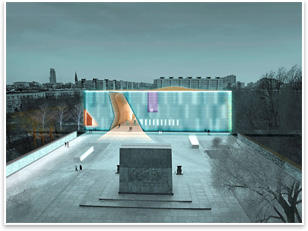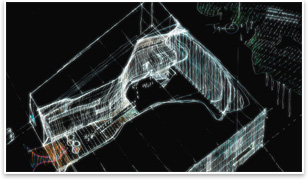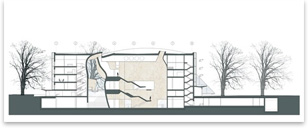Warsaw Museum Focuses on Jewish History and Tolerance
Museum of the History of Polish Jews breaks ground
by Heather Livingston
Contributing Editor
 Summary: A Warsaw museum by the Finnish architectural team Rainer Mahlamäki and Ilmari Lahdelma—dedicated to educating the public about the history and tolerance of 1,000 years of Jewish life in Poland—broke ground in late June, after more than a decade of planning. Located in the heart of what was Warsaw’s Jewish Quarter, the Museum of the History of Polish Jews (MHPJ) will be the only museum in the world to follow the history of Polish Jews from the Middle Ages to the present. Summary: A Warsaw museum by the Finnish architectural team Rainer Mahlamäki and Ilmari Lahdelma—dedicated to educating the public about the history and tolerance of 1,000 years of Jewish life in Poland—broke ground in late June, after more than a decade of planning. Located in the heart of what was Warsaw’s Jewish Quarter, the Museum of the History of Polish Jews (MHPJ) will be the only museum in the world to follow the history of Polish Jews from the Middle Ages to the present.
The five-story building was selected in 2005 in an international design competition. The museum is expected to open in 2009 at a cost of at least $65 million, not including the value of the land. Funding for the museum has come from private and public sources, including approximately $6.5 million from the German government, $13 million from the government of Poland, and myriad private donors and corporations in the U.S. and Europe.
Meaningful siting
Beginning in 1940, a portion of the Jewish Quarter became the Warsaw Ghetto as an estimated 440,000 people were forced into a small and densely populated part of the city. From the ghettos throughout Poland, the Nazis orchestrated their removal of Polish Jews to extermination camps. The Warsaw Ghetto was the site of the 1943 Warsaw Ghetto Uprising, a month-long fight against further deportation. In 1998, the Warsaw City Council donated 3.2 acres within the Warsaw Ghetto to the future MHPJ.
 Sited directly across the square from the museum is the 1948 Nathan Rappaport Memorial of the Heroes of the Warsaw Ghetto monument. The museum is a compact cube that was designed to complement rather than overshadow Rappaport’s monument. The defining element of the building is the large chasm that cuts through the museum from top to bottom and front to back, bathing the building and visitors in natural light. The dramatic gorge alludes to the miraculous parting of the Red Sea in the Torah, or Old Testament in the Christian faiths, through which Moses led the Jews out of captivity in Egypt. Rather than dwelling on the faith’s catastrophic events throughout history, the museum’s design foregrounds the life of the Jewish people throughout history. Its transparency alludes to the desire for truthful reckoning of the past. Sited directly across the square from the museum is the 1948 Nathan Rappaport Memorial of the Heroes of the Warsaw Ghetto monument. The museum is a compact cube that was designed to complement rather than overshadow Rappaport’s monument. The defining element of the building is the large chasm that cuts through the museum from top to bottom and front to back, bathing the building and visitors in natural light. The dramatic gorge alludes to the miraculous parting of the Red Sea in the Torah, or Old Testament in the Christian faiths, through which Moses led the Jews out of captivity in Egypt. Rather than dwelling on the faith’s catastrophic events throughout history, the museum’s design foregrounds the life of the Jewish people throughout history. Its transparency alludes to the desire for truthful reckoning of the past.
Design and function
The building exterior is prepatinated copper and tempered glass, with a double skin to protect against heat gain and offer sun protection. The building frame is concrete, with some site-cast exterior components. The curved walls and ceiling are faced in limestone and lighted from above. Entrance halls will be limestone and concrete. The museum’s public spaces will measure 140,000 square feet and feature eight central galleries that together total 43,000 square feet. The museum will offer a 500-seat auditorium, education center, reading room, library, research center with individual study stations, children’s play area, temporary exhibition spaces, and a restaurant.
 The MHPJ was designed to be a narrative multimedia museum. The account of the 1,000-year history of Polish Jews, in the form of the main exhibition in the museum, will be presented with modern technical methods including reconstruction, projection, and reproduction techniques, but also including original objects. The permanent exhibits chronologically explore Jewish life in Poland, beginning with First Encounters & Settlements: Jews in the Polish Lands, 10th through 15th Centuries, and closing with The Postwar Years: 1946 to the Present. The core of the permanent exhibit is being developed by a team of scholars, historians, and museum experts from Poland, Europe, Israel, and the United States. The MHPJ was designed to be a narrative multimedia museum. The account of the 1,000-year history of Polish Jews, in the form of the main exhibition in the museum, will be presented with modern technical methods including reconstruction, projection, and reproduction techniques, but also including original objects. The permanent exhibits chronologically explore Jewish life in Poland, beginning with First Encounters & Settlements: Jews in the Polish Lands, 10th through 15th Centuries, and closing with The Postwar Years: 1946 to the Present. The core of the permanent exhibit is being developed by a team of scholars, historians, and museum experts from Poland, Europe, Israel, and the United States.
The “crown jewel” of the museum and key element to serving both adults and children is the 5,400-square-foot education center. Designed to address the needs of individuals, families, students, and teachers, the education center hosts multimedia displays and Internet-based kiosks that provide access to the museum’s database of 60,000 documents and objects. Visitors will have access to the professionally staffed reading room, library, and individual study stations to guide research and lessons for school children will be offered to Polish students.
Hope and remembrance
During the groundbreaking ceremony, the Poland’s President Lech Kaczynski spoke of this project’s overwhelming sense of hope. “This museum offers a tremendous opportunity to overcome a mutual lack of understanding and achieve deeper reconciliation,” he said. “It goes without saying that the history of Polish Jews is part of the history of my country. In the broad sense of the word, it is a part of the history of my nation, one that needs to be remembered and heard.” |




